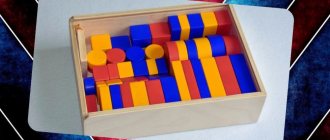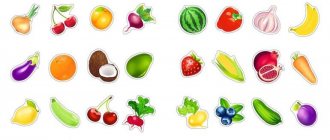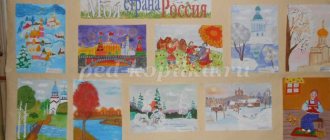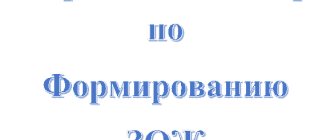The syllabic structure of a word is the order and number of syllables in words. The syllabic structure of a word refers to phonemic representations; it is the rhythmic construction of words in the native language. As a child grows up, he gradually learns to feel the rhythm of words on an intuitive level. Children with speech underdevelopment (FFSD, OSD) have difficulty mastering the syllabic structure of words; they need special remedial pedagogical training. Preschool children need to be presented with all the material in a playful, interesting form; for this purpose, special games have been developed to form the syllabic structure of words. To make it easier for a child to learn the structure of a word, the teacher needs to involve as much motor activity as possible, since with movement the child will better consolidate speech material. Words of different syllabic structures can be clapping, tapping, jumping, stepping away, and so on. 1. Pyramid game
Place a pyramid in front of the child, discuss it, then take it apart, and start putting on the rings, pronouncing words of different syllabic structures.
It is necessary to pronounce a syllable for each ring. 2. Playing with buttons
Invite your child to play with buttons, go through them, select buttons of different colors and sizes.
After sorting through the buttons, together with your child, lay them out in a row, pronouncing the words, one syllable for each button. The child should see the composition of the word, after you collect the word, repeat it again, and put the buttons collected in a row separately from the others, then discuss how you collected a lot of words, how well done you are! 3. Playing with balls
Let your child play with various small balls, leave them or roll them.
After this, invite the child to throw balls into the basin, pronouncing the words syllable by syllable. Practice this exercise with your child, gradually increasing the distance to the pelvis into which you need to throw the balls and the syllable structure of the spoken words. 4. Playing with a matryoshka
Together with your child, play with a matryoshka, disassemble and assemble it.
Then disassemble and assemble each small nesting doll separately and arrange the toys in a row, pronouncing the words syllable by syllable - for each toy one syllable. 5. Playing with geometric shapes
Invite your child to study the shapes: circle, square, triangle.
Separate all the figures into separate piles. Then, together with your child, lay out the figures in a row (for example, only circles) and pronounce the words syllable by syllable, for each circle a syllable. So play with all the figures. Then discuss with your child the number of words spoken and their length (words with one syllable are short, words with many syllables are long) 6. Playing with cubes
Take the cubes, build a tower or fence out of them, then invite the child to talk and pronounce the words syllable by syllable. , arranging the cubes in a row with a “fence”, one syllable for each cube.
7. Playing with children's seals
An adult invites the child to make a beautiful picture and gives him a seal. In a joint activity, adults and children print pictures in a row, pronouncing words syllable by syllable. For each printed picture - one syllable. Words printed syllable by syllable should be located separately from each other on a sheet of paper. Next, I bring to your attention speech material for practicing syllable structures of various levels of complexity. 1.SGSG Owl Zebu Scythe Goat Canopy Hay Notes Cinema Puma Coffee Winter Tody Melon Kiwi Sneakers Children Feet Veil Moon Water Cotton Foam Sky Flour 2.SGSG House Cat Kom Copper Fur Moss Ointment Whale Juice Catfish Network Shadow Nose Poppy Horse Dream 3.SGSGS Bison Fennec Pheasant Hamster Pig Python Banana Coconut Wagon Scoop Sock Lawn Scoop Boot Wreath Broom 4. SGSSGSG Dates Viper Cockatoo Navaga Kimono Domino Kiwano Dog Dishes Paper 5. SGSSGSG Panda Mango Pacifier Bag Folder Jar Semolina Casque Salmon Bongo Nandu Cap Sleigh Pasta Letter Dough Dachshund Discs Mask Board Bowl Bows 6. SSGS Gnome Snow Light Laughter Wardrobe Whip Sign Stack Stingray Steppe 7. SGSGSGSG Button Wolverine Pasta Turtle Spindle Pyramid 8. SGSGSGSG Scooter Shop Hippo Boot Flywheel 9. SGSGSGSGS TV Bicycle
Summary of GCD for literacy. Syllable. Dividing words into syllables. Senior group
Topic: Syllable. Dividing words into syllables. Purpose: To give an idea of the syllabic composition of a word. Objectives: To develop the ability to perform syllabic analysis, determining the number and sequence of syllables in a word; Formation of the ability to distinguish between words and syllables; Express your thoughts with sufficient completeness and accuracy, take into account different opinions; Activate and expand students' vocabulary; Conduct self-assessment Equipment: Demonstration material: plot picture, syllable patterns; Handouts: subject pictures, worksheets, simple pencil. Org. moment -Tell me, in what mood did you go to the garden today? I really want you to be in a good and cheerful mood throughout the day! I think the sun will help us with this. (illustration) The sun woke up in the sky. It made us guys smile. -Let us also give our smiles to each other and to our guests. Progress of the lesson 1. Introduction to new material - Today I want to tell you a story that happened in this forest (a picture is hung on the board). - What forest is this? “And so there lived a fox in the forest with her cubs, whose names were Tisha and Marisha. - What kind of foxes? -What do they like to do? — One day a fox went for a walk with her cubs. The fox cubs began to play and did not notice how they ran very far away. The fox began to call them: “Ti-sha, Ma-ri-sha.” -The fox cubs don’t hear. Let's call them together (Ti-sha, Ma-ri-sha). -They don’t hear again. Let's call them again (Ti-sha, Ma-ri-sha). -The cubs finally heard and came running back. And they promised never to run far away again. -When we called the fox cubs, we pronounced the word in parts. Listen again. Ti-sha, Ma-ri-sha. -When we pronounce a word in parts, it means that we divide it into syllables. -Listen to how I now pronounce the word fox and clap my hands for each syllable. -Let's get together (Li-sa) -How many syllables are in this word? What is the first, second? -What are fox cubs called? (little foxes) Let's divide the next word (Li-sya-ta). How many syllables? Which one is 1, which one is 2, 3. Dynamic pause - I suggest we take a walk through this forest. I invite you to go for a walk in the autumn forest. We guys can't find a more interesting adventure. Reinforcing new material 1. Game “Where will the word go?” Each child must divide the word into syllables, determine the number of syllables and occupy the “house” that corresponds to the number of syllables in the word. -While we were walking, I found a basket. Let's see what's in it? -There are words in it and they get lost. Let's help them find their home? -But for this, words need to be divided into syllables. -Remember how we mean the word? (One line) ________ -How to indicate that this is a “house” for words that have 2 syllables? (Divide the word into 2 parts) (One child is invited to the board and divides the word diagram into two parts) How many syllables will the words of this “house” consist of? (of 2 syllables) Who guessed what words would live in this house? (Words with 3 syllables) Why do you think so? (Because the word diagram is divided into 3 parts) - Take one picture each. Children take and say their word. When all the pictures have been distributed, the teacher asks the children to occupy the desired house. - Words with 2 syllables (3 syllables) occupy your house. Checking the completed task. 2. Game “Word-syllable”. - I suggest you play. I will name a word or syllable. If you hear a syllable, clap, and if you hear a word, jump. Ma, winter, si, strength, mice, shi, zi, basket, yes, water, game, ra. Be so kind, children, sit quietly at the tables. The children sit at the tables. 3. Independent work of children. So that we would not forget about our walk, the inhabitants of the forest sent us a picture. Let's name what is depicted on it. (cloud, owl, crow, birch, fox, raspberry) What do you think needs to be done in this task? (Connect the illustrations with suitable diagrams. Check. Let's check how you coped with the task, and to do this, swap your works. How many syllables are in the word raspberry? (The word raspberry has 3 syllables) Which diagram did you connect with? (With diagram No. 2) Similarly the rest of the words are checked. On the board there is a standard of the correct answer. (The teacher “with the help” of the children shows how to correctly connect the illustrations and diagrams) Who found the errors? (Specify what errors were found)
Summary of the lesson -What did we learn during the lesson? (Divide words into syllables, distinguish between words and syllables) - Which of you needed help completing the task? — Who completed all the tasks without mistakes? - Attach your autumn leaf to the “Tree of Success” - red - everything worked out, yellow - not everything worked out.
We recommend watching:
Summary of educational activities in the senior group “Journey to a Fairy Tale” Summary of a mathematics lesson for children of the senior orthopedic group Summary of educational and gaming activities in the senior group in the section of the “Childhood” program Synopsis of educational activities for the perception of music in the senior group of kindergarten
Similar articles:
Lesson in the senior group of kindergarten on the topic of February 23
Lesson notes for children of senior preschool age. Topic: Invisible air
Summary of organized educational activities for children of the senior group
Notes for mathematics classes in the senior group
Lesson summary on the topic “Reserve” in the senior group









